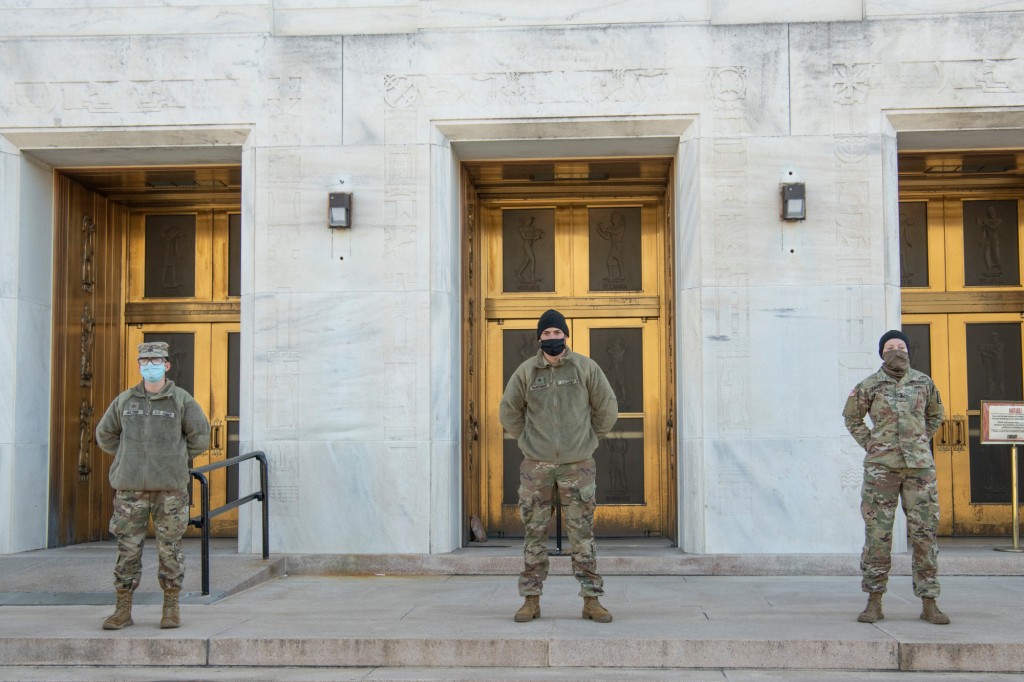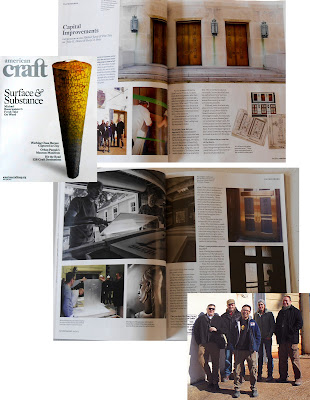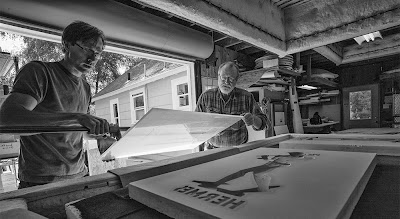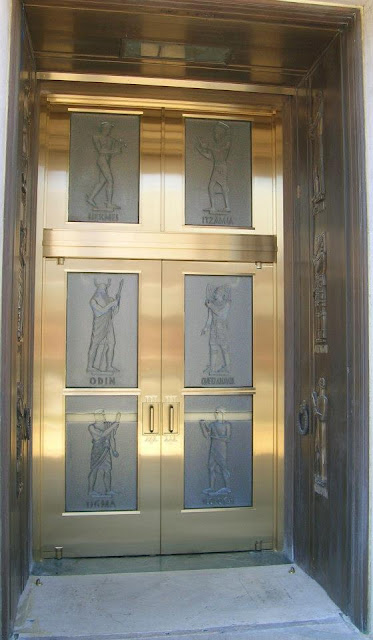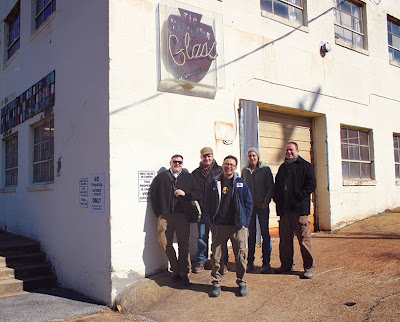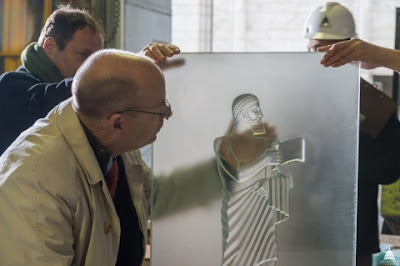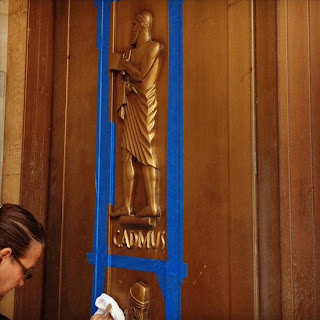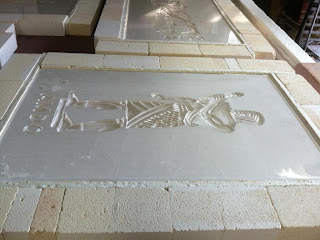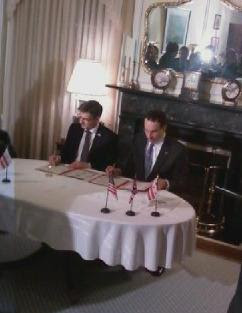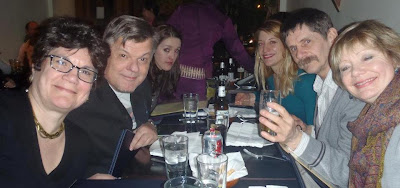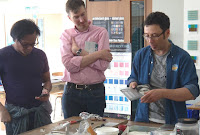Hugs to all as the Fulbrighters returned home to Washington, DC, determined to reinforce the connections made. Right after the boys left Sunderland, Creative Cohesion’s artist facility was damaged as the adjacent building partially collapsed during a strong windstorm, closing the artist center until later in the year.
 Sean Hennessey was in the news as Washington’s historic Howard Theater re-opened to fanfare. Working with Brower Hatcher and Mid-Ocean Studios, Sean created the concrete and glass trumpet form for the team.
Sean Hennessey was in the news as Washington’s historic Howard Theater re-opened to fanfare. Working with Brower Hatcher and Mid-Ocean Studios, Sean created the concrete and glass trumpet form for the team.
At the opening, Sean was interviewed by National Public Radio (NPR).
Erwin Timmers was one of the 121 featured artists at the 30th Annual Smithsonian Craft Fair.
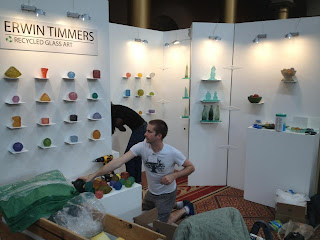 |
| Erwin Timmers and Mick Coughlin set up at the National Building Museum. |
His cast recycled glass sculptures were a strong point of the show at the National Building Museum.
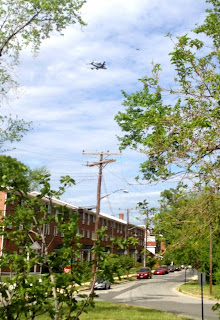 |
| Space Shuttle Discovery does a low flyover the Washington Glass School in April. |
NASA’s Space Shuttle program was retired, and the shuttle “Discovery” flew over the glass school as it headed out across the country. We ate “astronaut freeze dried ice cream” in its honor.
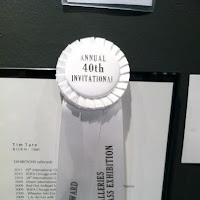 |
| Tim Tate’s glass and video sculptures received the “Critics Award” at Habatat Galleries 40th Annual International exhibit in Michigan. |
Habatat Galleries held its 40th Annual International invitational, and exhibited Tim Tate’s video reliquaries. Tim’s work won the Critic’s Award at the show.
_____________________________________________
May
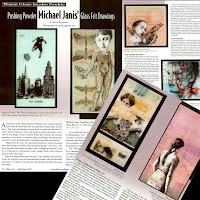
 May started off running with Glass Art Magazine having an article about Erwin Timmers eco-glass and a cover story about Michael Janis’ frit powder drawings – creating a publishing two-fer! The magazine also late ran a special online feature about Tim Tate & Michael Janis’ Fulbright adventures.
May started off running with Glass Art Magazine having an article about Erwin Timmers eco-glass and a cover story about Michael Janis’ frit powder drawings – creating a publishing two-fer! The magazine also late ran a special online feature about Tim Tate & Michael Janis’ Fulbright adventures.
Some great photos by Pete Duvall of Anything Photographic filled the 10 pages of articles about Erwin and Michael.
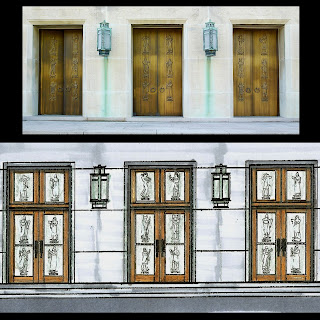 |
| The design concept for the LOC Adams building doors. |
 |
| Rubber mold from one of the LOC sculptures. |
The Washington Glass Studio began working on the Library of Congress Adams Building doors in May, working to recreate the historic sculpted bronze doors in cast glass. The project integrates a number of artists from the Washington Glass School and connects craft artisans from FireArt Glass in Portland, OR. Sean Hennessey started the process by creating a test panel taken from the original doors. There would be a full size sample made of the cast /laminated artwork panel, submitted to the US Architect of the Capitol for approval.
 |
| Dave D’Orio’s artwork awarded by the JRA. |
Artomatic 2012 – the month long, non-juried, anything-goes exhibit opened in May. This year, the setting was a soon-to-be-demolished office building in Crystal City. The James Renwick Alliance (JRA) is an independent national nonprofit organization dedicated to advancing scholarship and education on contemporary American craft, to supporting activities directed toward this purpose, and to encouraging connoisseurship and collecting. At this Artomatic, the JRA sponsored activities and programs, and had reviewed the 10 floors of artwork, selecting winners in different media.
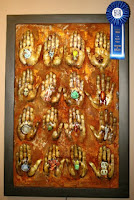 |
| Sean Hennessey’s artwork awarded by the JRA |
Dave D’Orio, Sean Hennessey and Michael Janis were each selected for their works in glass. The JRA also sponsored receptions and artist talks during the event. (FYI- The not-for-profit organization Artomatic.org has been instrumental in organizing international exhibits that brought together Sunderland artists and the Washington Glass School, and some new plans are being developed for the coming year.)
_____________________________________________
June
2012 was anniversary year marking the start of the American Studio Glass Movement in 1962. A number of shows were held this summer to give some insight into how the art form has changed during the past 50 years. In the arty city of Asheville, NC, Bender Gallery showcased Erwin Timmers, and Asheville’s Blue Spiral 1 hosted a show about the next generation of glass artists (including Christina Bothwell, Thor & Jennifer Bueno, Susan Taylor Glasgow, Sean Hennessey, Michael Janis, Marc Petrovic, Tim Tate and others).
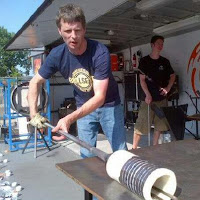 |
| Marc Petrovic demo’s at GAS |
 |
| Laura Donefer works the runway. |
The Glass Arts Society (GAS) held its annual conference in the nominal birthplace of the studio glass movement – Toledo, OH. Said Tim Tate of the Toledo GAS – “
[Outgoing GAS President] Jeremy Lepisto’s gang did a spectacular job! and Laura Donefer’s fashion show blew me away!”
_____________________________________________
July
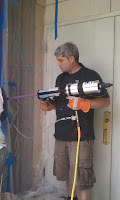 |
| Sean Hennessey gets serious at the LOC. |
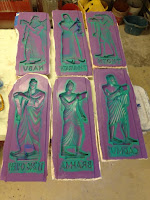 |
| The panel molds are cleaned in the studio. |
The month of July was a scorcher! Work continued on the US Library of Congress bronze doors in the sun with temps in the mid ’90’s F (mid 30’s C!). The “rockets red glare” refers to how hot it feels. Sean and crew worked in the brutal heat taking rubber molds from the Lee Lawrie bronze sculpted doors.
The Renwick Gallery of the Smithsonian Museum opened its spectacular “Craft Futures – 40 Under 40” exhibit. 40 under 40:Craft Futures features forty artists born since 1972, the year the Smithsonian American Art Museum’s contemporary craft and decorative arts program was established at the Renwick.
 |
| Matt Szosz at the opening of 40 Under 40. |
 The show, curated by Nicholas Bell, showed how the youngsters in craft are remaking the world of craft.
The show, curated by Nicholas Bell, showed how the youngsters in craft are remaking the world of craft.
This show generated many discussions on how craft is no longer a part of the “apprentice to a master” world, and is one where the young students wish not to be tied to any one craft media.
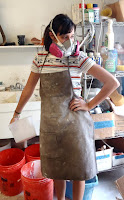 |
| Audrey Wilson models the latest in cold shop fashion. |
Speaking of kids today, in July, Audrey Wilson joined the Washington Glass School as the new studio coordinator. Audrey had met Tim Tate when he was teaching a workshop at the Chrylser Museum of Glass in June, and applied for the position.
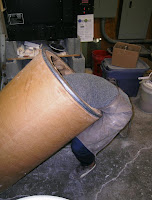 |
| Elegance comes to the Glass School. |
Audrey soon was teaching classes at the Glass School, and her accessible and welcoming teaching style won over many of the artists at the studio.
______________________________________________
August
In August, the Brentwood Arts Exchange (part of Maryland’s Prince George’s Parks and Recreation) held part of its summer Creative Expressions Camp encouraging the kids to explore a variety of artistic media as well as contemporary reading and writing activities around such themes as animals, nature, and adventure.
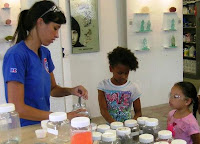
 The studio was overrun with kids, all eager to try working in glass. Some showed an intuitive knack for the craft – Who knows where these young artists will take the medium and artworld as they grow up!
The studio was overrun with kids, all eager to try working in glass. Some showed an intuitive knack for the craft – Who knows where these young artists will take the medium and artworld as they grow up!
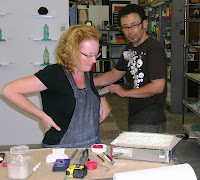
Ceramic artist Novie Trump worked in the studio, working to incorporate glass into a commissioned artwork piece. Novie wanted to make an illuminated hive for an installation of ceramic bees. Novie made a number of fused glass alternates and presented to the client – a trendy restaurant in Georgetown.
Ultimately, however, the architect selected a ceramic version for the installation. We will get her to glass somehow, we will not surrender.
 |
| An impressive steed. And a handsome horse too. Michael Janis as a Beltway Cowboy. |
The London Olympics were celebrated here as the Washington Glass School hosted the equestrians dressage events along Otis Street. In Mt Rainier, MD. Ok, the 2012 Summer Olympics did not take place at the Washington Glass School, but the 2012 National Night Out (NNO) did. The NNO is a campaign that involves citizens, police, neighborhoods and local officials to increase crime and drug prevention and to strengthen police-community partnerships.
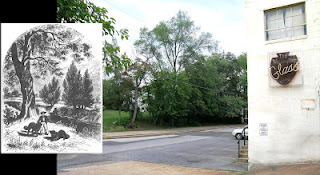 |
Then & Today
Left inset: Engraving (ca. 1860) of battlefield site where Joshua Barney fell by Benson Lossing in “Field Book of the War of 1812 “ ; Right: Washington Glass School on the same site. Over the past 200 years, the topography has been modified and changed tremendously – the creek now flows under the concrete pathway opposite the Glass School. |
Connections to American history was exposed in the August post about how the Glass School’s Mount Rainier building site was part of a key battle in the War of 1812 – in the Battle of Bladensburg. With the US loss at this battle, British forces swept into Capitol Hill and burned the White House, the Capitol and the Treasury.
 |
| Penland School of Craft Auction Tent, 2012 |
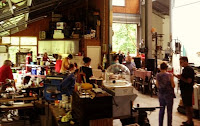 |
| Michael Sherrill’s incredible studio |
An ardent support of the Penland School of Craft, Tim Tate took a group of collectors from the James Renwick Alliance to the annual Penland Auction and as part of the “Tim Tate Tour“.
The group visited the artist studios of Hoss Haley, Michael Sherrill, Dan Essig, Christina Cordova & Pablo De Soto and Stoney Lamar.
 |
| Glass artist Beth Lipman with Susan and Fred Sanders at Penland. |
The excursion also included an art tour of Asheville, NC with a visit to the Glass Secessionism show at Blue Spiral Gallery.
_____________________________________________
September
 |
| Carol Trawick, David D’Orio & Catherine Leggett. Photo: Bethesda Urban Partnership |
September opened big for artist Dave D’Orio, as he was one of this year’s winner of the Trawick Prize.- a visual art prize produced by the Bethesda Arts & Entertainment District that honors artists from Maryland, Washington, D.C. and Virginia. The annual juried competition awards prize money to selected artists and features the work of the finalists in a group exhibition. Dave is the executive director of DC GlassWorks, a glass blowing facility (and sister school to the Washington Glass School) in Hyattsville, MD. At the 2012 Artomatic, the James Renwick Alliance gave Dave’s installation sculpture its ‘Award of Recognition’.
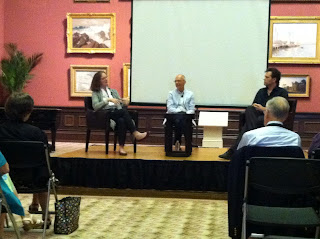 |
| Toots Zynsky, William Warmus, Matthew Szösz at Smithsonian Renwick lecture. |
 |
| William Warmus takes photos of Erwin Timmers’ artwork. |
The 40 Under 40 exhibit at the Renwick Gallery continued its run, with author, independent curator and glass expert William Warmus moderating a conversation about the past, present, and future of studio glass between veteran glass artist Toots Zynsky and artist Matthew Szösz. After the talk, William visited the Glass School – of which he said: “It’s better than I thought it’d be…it’s not as bad as it could’ve been“. Hmmm.
The month of September is usually the start of the exhibition season – and this one did not disappoint.
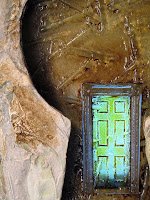 |
| Detail from Sean Hennessey’s “Finding The Right Key“ |
Sean Hennessey opened his solo show at the District’s 410Goodbuddy Gallery.
Based on Alice In Wonderland, Sean’s work in the show: Reimagining Alice incorporates cast glass that was painted with concrete and integrates videos, LEDs, EL panels and other media that pulls traditional glass into new realms.
 Tim Tate and Marc Petrovic also had openings in September – at Arizona’s Mesa Contemporary Arts Museum. Under the title “Glass Secessionism”, the show opened to record crowds.
Tim Tate and Marc Petrovic also had openings in September – at Arizona’s Mesa Contemporary Arts Museum. Under the title “Glass Secessionism”, the show opened to record crowds.
_____________________________________________
October
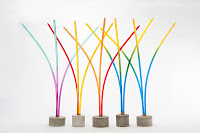
Nancy Donnelly‘s solo show at Foundry Gallery included her “Glass Bouquets” that art critic Lenny Campello described as an update to the Washington Color School saying “… [Nancy’s] new work takes the color stripes from the canvas of the 1960s giants of DMV painting and re-invents it in a fresh new approach to a 21st century dialogue in glass and concrete”.
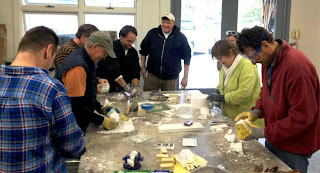 |
| Tim Tate teaching at Penland School of Craft |
Tim Tate returned to North Carolina’s Penland School of Craft in October, this time teaching with Sean Hennessey and Robert Kincheloe.
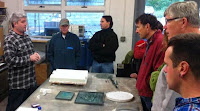 |
| Sean Hennessey explains the dry plaster casting process. |
The class was 21st Century Reliquaries, and the students incorporated techniques that included Rubber Mold Making, Wax Casting, Plaster/Silica Mold Making, Lost wax, Dry Plaster Casting, Painting Glass, Cutting Glass, Glass etching and Flameworking.
_____________________________________________
November
November started with the big show in Chicago – SOFA!
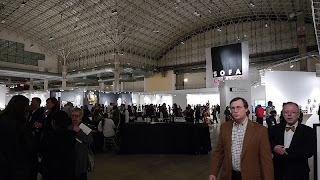 |
| SOFA Opening Night at Chicago’s Navy Pier |
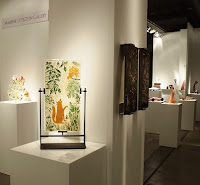 |
| Allegra Marquart’s panels on exhibit at Maurine Littleton. |
Michael Janis and Allegra Marquart were shown at Maurine Littleton Gallery and Tim Tate was shown thru Habatat Galleries. As the focus on both craft and art at SOFA is so high, this show is where the artists have stretched a bit to show they have game.
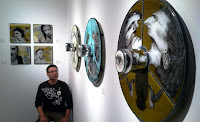 |
| Michael Janis’ works were huge! |
Michael’s new colorful works involved optical distortion and the resolution of the imagery.
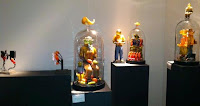 |
| Tim Tate’s works at Habatat Galleries space. |
Tim’s new works were a larger scale – and he was thinking outside the dome.
Upon return to Washington, DC – the setup of shows continued, as artists from the Washington Glass School were featured in the special exhibit on the 50th Anniversary of Studio Glass at the Washington Craft Show.
 |
| Visitors gather around Joan Falconer Byrd, author of the new book “Harvey K Littleton: A Life in Glass“. Ms Byrd was one of the show’s speakers at the event. She was one of the first students in the Toledo workshops and was Professor of Art at Western Carolina University. |
Maurine Littleton Gallery’s show-within-a-show was the centerpiece to the Washington Convention Center.
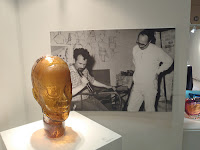 |
| Historical works by some of the Studio Glass Pioneers were featured. |
Works by Tim Tate, Allegra Marquart, Sean Hennessey, Erwin Timmers, Alison Sigethy and Michael Janis were shown as where the next generation of glass artists are heading.
______________________________________________
December
 |
| Art Miami’s Aqua show brought throngs. |
Miami became the focus of the art world with the Art Basel/Art Miami juggernaut as the world seems to head south for the huge art extravaganza. Washington Glass School artists were well represented, with Tim Tate, Erwin Timmers, Sean Hennessey and Audrey Wilson’s works at a number of international galleries.
Audrey did very well, selling a major work to a NYC collector and a museum has asked about having her work for an upcoming art exhibit – awesome!
Everyone at the Washington Glass School sends a big THANK-YOU to all for the love & support this past year…
______________________________________________
So – should one survive the Zombie Mayan Long Count Armageddon –
Whats coming up in 2013?
We can divulge some news scoops for the coming year –
Michael Janis will be the Art Alliance for Contemporary Glass (AACG) calender boy for the month of January, as the “Artist of the Month”. January… starts the year off right…
Artomatic is planning to host a variation of the Glass 3 (the international exhibition US & UK artists) however, this year, it will be an international Glass + Ceramics showcase at downtown DC’s Edison Gallery – the month of March is being blocked out for the opening, gallery talks, workshops, and events.
Glassweekend will take place at New Jersey’s WheatonArts this coming June 7,8,9, 2013. The international symposium of contemporary glass will have demos by Beth Lipman, Davide Salvadore, Hiroshi Yamano; the keynote speaker will be Judith Schaecter.
Best Wishes to all for the Coming New Year!
Posted in aqua, art miami, battle of bladensburg, congress, Craft Show, creative cohesion, discovery space shuttle, facture, glass art magazine, habatat galleries, library of, LOC, sofa lab, sunderland, year in review
With the Memorial Day Weekend here, a blog posting that touches on themes of American Art & history is in order.
 |
| Library of Congress, Washington, DC, Adams Building |
The Process looks at how the Washington Glass Studio artists are recreating the original, historic bronze doors from the Library of Congress (LOC) Adams Building in kiln-cast glass.
As mentioned in an earlier post, the Architect of the Capitol (AOC) oversees this landmark building, and they sought out ways to provide up-to-date functional aspects for their structures, all while balancing the requirement for maintaining the artistic legacy of its buildings – a daunting task in an ever changing world. Their design for the LOC Adams building was to have the historic bronze entry doors (that could not be brought up to code) set in the “open” position, and install new code-compliant functional glass doors for the public access – with the glass doors designed to reference the original door sculptures. (Click HERE to jump to link post of sculpted bronze door features.) Washington Glass Studio is creating the new cast glass panels, and this edition of The Process looks at how the molds are being taken from the original doors in-situ.
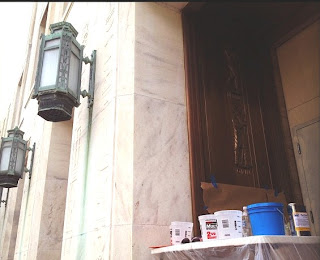 |
| Sean Hennessey, the master caster, sets up his mold making equipment and preps the doors. |
The LOC was very concerned that the mold taking process could adversely impact the patina of the bronze doors, so before any work on the doors was completed, testing of the materials and release agents were conducted on an inconspicuous section of the backside of the doors.
 |
| A section of the door backside was tested for any reaction to the materials. |
 |
| The sample came off with no residue or impact to the original bronze finish. |
 |
| Given the go-ahead, Sean enjoys a day in the sun. |
 |
| The bronze door area surrounding the bas-relief is masked off. |
 |
| Care is taken for the surrounding area. Sean shown here assisted by Erin Cumbo. |
 |
| The layering of the silicone rubber mold material starts. |
 |
| The mold is allowed to set-up until firm, and then peeled off. |
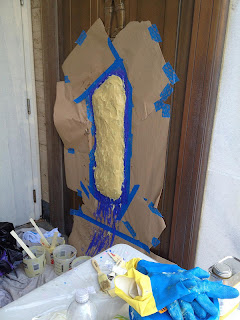 |
| “Mother Mold” material is added to give structural strength to the casting. |
 |
| The finished rubber mold. |
The molds will later be used to create the original forms for the kiln-casting process – more about the glass casting process in later postings!.
Posted in adams building, AOC, architect of the capitol, architectural application glass, historic glass art, lee lawrie, library of congress, LOC
>
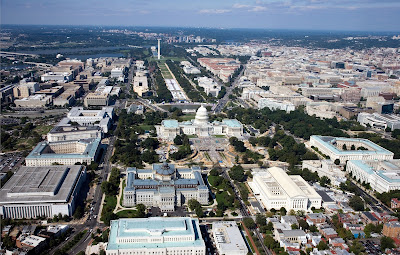 |
| Aerial view of US Capitol on the Mall, Washington, DC. Library of Congress is center bottom of photo. |
The Washington Glass Studio (WGS) has started the creation of the new cast sculptural glass doors for the Library of Congress (LOC) in Washington, DC. The design of the project started in 2004, when the Architect of the Capitol (AOC) first asked WGS about advise on their initial proposal to replace the original historic bronze doors of the LOC Adams Building, as the doors required security and changes to be code-compliant. The AOC also sought to reference the artistic heritage of the original doors in this important United States building.
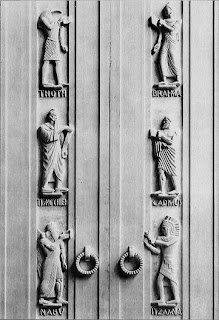 |
| One of the original bronze door pairs by sculptor Lee Lawrie |
The original (11′-0″H) bronze doors had functional issues and will be retained in their present hold-open position, recessed into architectural niches. The 16 sculpted bronze doors feature high-relief sculptures by American artist Lee Lawrie, whose best known work is the architectural sculpture on and around New York’s Rockefeller Center. Lawrie’s bronze doors were designed to commemorate the history of the written word, depicting gods of writing as well as real-life Native American Sequoyah.
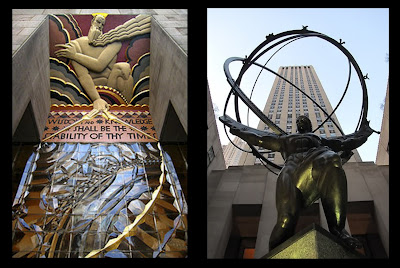 |
| Lee Lawrie, 1877-1963, American sculptor, best known for his architectural work at NY’s Rockefeller Center, especially for the free-standing “Atlas” sculpture. |
 |
| Ogma and Sequoyah, sculpted bronze figures by Lee Lawrie. Door detail, Library of Congress John Adams Building, Washington, DC. |
The original bronze figures depict:
- Hermes, the messenger of the gods
- Odin, the Viking-Germanic creator of the runic alphabet
- Ogma, the Irish god who invented the Gaelic alphabet
- Itzamna, the Mayan god
- Quetzalcoatl, the Aztec god
- Sequoyah, a Native American
- Thoth, an Egyptian god
- Ts’ang Chieh, the Chinese patron of writing
- Nabu, an Akkadian god
- Brahma, an Indian god
- Cadmus, the Greek sower of dragon’s teeth
- Tahmurath, a Persian hero
The new door design incorporates cast glass panels mounted within a bronze framework, incorporating current egress and security requirements. The kilnformed sculptural glass will be made from molds taken off the original door sculptures. Using clear Bullseye glass to cast, the sculpted glass panels will then be laminated to tempered glass for safety. The new glass doors will create a contemporary luminosity to the building entrances, while keeping the character of the historic landmark structure.
 |
original bronze doors – east side (top)
Design of new bronze and cast glass doors – west side (bottom) |
The scale of the project has prompted a collaboration between Washington Glass Studio and Fireart Glass Studio in Portland, OR. The project “dream-team” includes (Bullseye Glass co-founder) Ray Ahlgren, Erwin Timmers, Michael Janis, Tim Tate and Sean Hennessey.
Master mold caster, Sean Hennessey, has started the project, creating the molds from the existing bronze doors in-situ. Some photos of that process will be posted later.
Posted in architect of the capitol, architectural application glass, contemporary sculpture, fireart glass, fused glass sculpture, historical glass art, kiln-formed, landmark, library of congress, LOC, ray ahlgren, wgs
